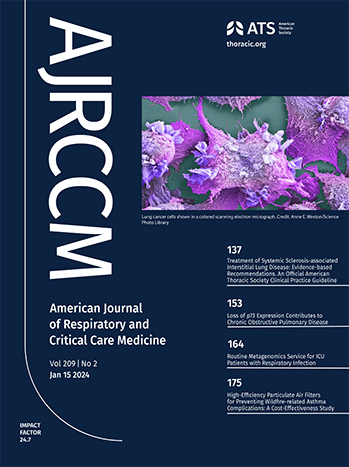Trial Analysis and Interpretation in Critical Care Using the Evidential (Likelihood) Approach: Rationale and Practical Considerations.
IF 19.3
1区 医学
Q1 CRITICAL CARE MEDICINE
American journal of respiratory and critical care medicine
Pub Date : 2025-07-01
DOI:10.1164/rccm.202504-0809tr
引用次数: 0
Abstract
Selecting the optimal methodological framework for evidence synthesis presents a fundamental challenge in contemporary clinical research. In critical care, where many interventions yield inconclusive results under traditional p-value-based analyses, complementary analytical approaches can enhance our understanding of trial data. While frequentist statistics remain predominant and Bayesian methods have recently experienced a resurgence of interest, the evidential (or likelihood) framework offers a methodological perspective that potentially bridges these two inferential paradigms. In this Concise Translational Review, we introduce readers to the evidential approach. To present the evidential approach as an analytical tool for critical care trials, we demonstrate its application using data from two mechanical ventilation trials (the Alveolar Recruitment Trial [ART, n=1,010] and the STrAtegy for coMmunIty acquired pNeumoniA trial [STAMINA, n=214]) and one trial evaluating balanced solutions (Balanced Solutions in Intensive Care Study - BaSICS, n=10,520). We focus on how concepts and terminology translate across paradigms, the framework's measures of effect (i.e., likelihood ratios, support values, and S intervals), proposals for its use in sequential analysis and trial monitoring, and how to report results from this framework in research articles. We propose that the evidential framework provides a clinically intuitive approach to trial interpretation by focusing on the relative evidence between competing hypotheses, thereby offering additional and complementary insights that align with clinical reasoning processes. To facilitate implementation by the scientific community, we have developed an interactive Shiny (open-source web-based) application (https://fzampier.shinyapps.io/Likelihood_Shiny/). This article is open access and distributed under the terms of the Creative Commons Attribution Non-Commercial No Derivatives License 4.0 (http://creativecommons.org/licenses/by-nc-nd/4.0/).使用证据(可能性)方法的重症监护试验分析和解释:基本原理和实际考虑。
为证据合成选择最佳的方法学框架是当代临床研究的一个基本挑战。在重症监护中,许多干预措施在传统的基于p值的分析下产生不确定的结果,补充分析方法可以增强我们对试验数据的理解。虽然频率统计仍然占主导地位,贝叶斯方法最近又重新引起了人们的兴趣,但证据(或可能性)框架提供了一种方法论视角,可以潜在地连接这两种推断范式。在这篇简明的翻译评论中,我们向读者介绍证据方法。为了将证据方法作为重症监护试验的分析工具,我们使用两项机械通气试验(肺泡招募试验[ART, n=1,010]和社区获得性肺炎策略试验[STAMINA, n=214])和一项评估平衡解决方案的试验(重症监护研究中的平衡解决方案- BaSICS, n=10,520)的数据来证明其应用。我们关注概念和术语如何跨范式转换,框架的效果度量(即,似然比,支持值和S间隔),在序列分析和试验监测中使用该框架的建议,以及如何在研究文章中报告该框架的结果。我们建议,证据框架通过关注相互竞争的假设之间的相关证据,为试验解释提供临床直观的方法,从而提供与临床推理过程一致的额外和互补的见解。为了方便科学界的实施,我们开发了一个交互式的Shiny(基于web的开源)应用程序(https://fzampier.shinyapps.io/Likelihood_Shiny/)。本文在知识共享署名非商业禁止衍生品许可4.0 (http://creativecommons.org/licenses/by-nc-nd/4.0/)的条款下开放获取和分发。
本文章由计算机程序翻译,如有差异,请以英文原文为准。
求助全文
约1分钟内获得全文
求助全文
来源期刊
CiteScore
27.30
自引率
4.50%
发文量
1313
审稿时长
3-6 weeks
期刊介绍:
The American Journal of Respiratory and Critical Care Medicine focuses on human biology and disease, as well as animal studies that contribute to the understanding of pathophysiology and treatment of diseases that affect the respiratory system and critically ill patients. Papers that are solely or predominantly based in cell and molecular biology are published in the companion journal, the American Journal of Respiratory Cell and Molecular Biology. The Journal also seeks to publish clinical trials and outstanding review articles on areas of interest in several forms. The State-of-the-Art review is a treatise usually covering a broad field that brings bench research to the bedside. Shorter reviews are published as Critical Care Perspectives or Pulmonary Perspectives. These are generally focused on a more limited area and advance a concerted opinion about care for a specific process. Concise Clinical Reviews provide an evidence-based synthesis of the literature pertaining to topics of fundamental importance to the practice of pulmonary, critical care, and sleep medicine. Images providing advances or unusual contributions to the field are published as Images in Pulmonary, Critical Care, Sleep Medicine and the Sciences.
A recent trend and future direction of the Journal has been to include debates of a topical nature on issues of importance in pulmonary and critical care medicine and to the membership of the American Thoracic Society. Other recent changes have included encompassing works from the field of critical care medicine and the extension of the editorial governing of journal policy to colleagues outside of the United States of America. The focus and direction of the Journal is to establish an international forum for state-of-the-art respiratory and critical care medicine.

 求助内容:
求助内容: 应助结果提醒方式:
应助结果提醒方式:


